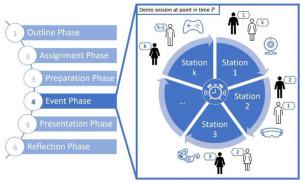Overcoming Integration Hurdles: Effective Strategies for VR/AR in Education Curricula
Introduction: Immersive Learning on the Rise
Virtual Reality (VR) and Augmented Reality (AR) are rapidly transforming education,offering unprecedented immersive experiences that boost engagement and comprehension. Despite their promise, integrating VR/AR into educational curricula presents meaningful challenges—from infrastructural limitations to staff training needs. This article explores proven strategies to overcome these integration hurdles,unlock the full potential of VR/AR in education,and position your institution at the forefront of digital learning innovation.
Why Integrate VR/AR into the Classroom?
- enhanced Engagement: Students interact with concepts, increasing attention and retention.
- Experiential learning: Immersive environments make abstract ideas tangible.
- Accessibility: Simulations overcome geographic, socio-economic, or physical barriers.
- Skill Development: Realistic practice in fields like medicine, engineering, and science.
- Differentiated Instruction: Tailored experiences for varied learning styles and needs.
Despite these VR/AR benefits for education, many educators struggle to integrate these technologies into daily teaching. Let’s dive into the hurdles and actionable solutions.
Identifying Common VR/AR integration Hurdles
- High Cost of Hardware and Software
- Lack of Educator Training
- Insufficient Infrastructure or Technical Support
- Limited, Curriculum-Aligned Content
- student Accessibility and Equity Issues
- Resistance to change
understanding these barriers is the first step to developing effective VR/AR integration strategies in education.
Proven Strategies to Overcome Integration Hurdles
1. Start Small with Pilot Programs
Launching a targeted pilot program minimizes risk and allows educators to test VR/AR tools in a controlled surroundings. Gather feedback, iterate, and refine before scaling.
- Choose one subject area
- Work with motivated teaching staff
- Set clear learning objectives
- Measure outcomes for continuous improvement
2. Invest in Professional Development
Teachers are the linchpin of accomplished tech adoption. Equip them with hands-on workshops, online courses, and peer mentoring focused on VR/AR teaching strategies.
- Organize regular VR/AR training sessions
- Encourage knowledge sharing via school networks
- Create user guides and video tutorials
3. Build Strategic Partnerships
Collaborate with edtech companies, VR/AR developers, and local businesses. Many offer pilot kits, reduced rates, or joint curriculum development to reduce initial investment.
- Explore educational grants and sponsorships
- Connect with local universities and technology incubators
- Join industry consortia for shared resources
4.Focus on Content Alignment
VR/AR content must support standards-based instruction, not distract from it. Work with content creators to ensure relevance to your curriculum.
- Review available lesson modules for alignment
- Offer feedback to developers for customization
- Encourage student-generated VR/AR projects
5. Address Equity and Accessibility
Ensure all students, irrespective of background or ability, benefit from immersive learning experiences.
- Schedule shared device programs for equitable access
- Choose solutions with built-in accessibility features
- Seek grants to support underserved communities
6. Provide Robust Technical Support
Reliable tech support minimizes downtime and maximizes educator confidence.
- Designate a VR/AR technology coordinator
- Leverage support from vendors and IT departments
- Create troubleshooting documentation
Case study: Successful Integration in a STEM Curriculum
Greenwood High School deployed an augmented reality biology unit for grade nine. They began with a month-long pilot, collaborating with an edtech partner to refine lesson plans and provide staff training. Key results included:
- Student engagement scores rose 35%
- Knowledge retention doubled compared to textbook-only classes
- Teachers reported increased ease in explaining complex topics
By focusing on targeted professional development, content alignment, and ongoing technical support, Greenwood reduced integration hurdles and set a template for future VR/AR adoption.
practical Tips for Educators: Making VR/AR Work for You
- Start with free or low-cost apps: Evaluate options before investing heavily.
- Use mobile devices: Many AR activities run on common smartphones or tablets.
- Integrate gradually: Blend VR/AR experiences with existing activities for smooth transitions.
- encourage student feedback: Involve learners in evaluating and improving the experience.
- Document successes: Share results with stakeholders to build support for expansion.
First-Hand Experience: Voices from the Classroom
“Augmented reality field trips allowed our students to visit ancient egypt without leaving the classroom. Their enthusiasm was contagious, and their written reflections showed deeper understanding. The key was giving teachers time and support to play and learn before rolling out lessons.”
— Sarah L., Social Studies teacher
“When our science department adopted VR labs, fear of technology melted away after a casual demo and Q&A session. I realized students were eager — it was us adults who needed reassurance!”
— Tom C., Technology Coordinator
Conclusion: building Future-Ready Classrooms
Overcoming the hurdles of VR/AR integration in education curricula requires a thoughtful blend of leadership, collaboration, investment, and creativity.By starting small, prioritizing educator empowerment, leveraging partnerships, and focusing on equity, schools can transform challenges into opportunities for every student.
As immersive technology continues to evolve, those who act early and decisively will reap the rewards of more engaged learners, improved achievement, and a reputation for educational innovation. The future of learning is immersive—let’s embrace it.

